Physical Address
304 North Cardinal St.
Dorchester Center, MA 02124
Physical Address
304 North Cardinal St.
Dorchester Center, MA 02124
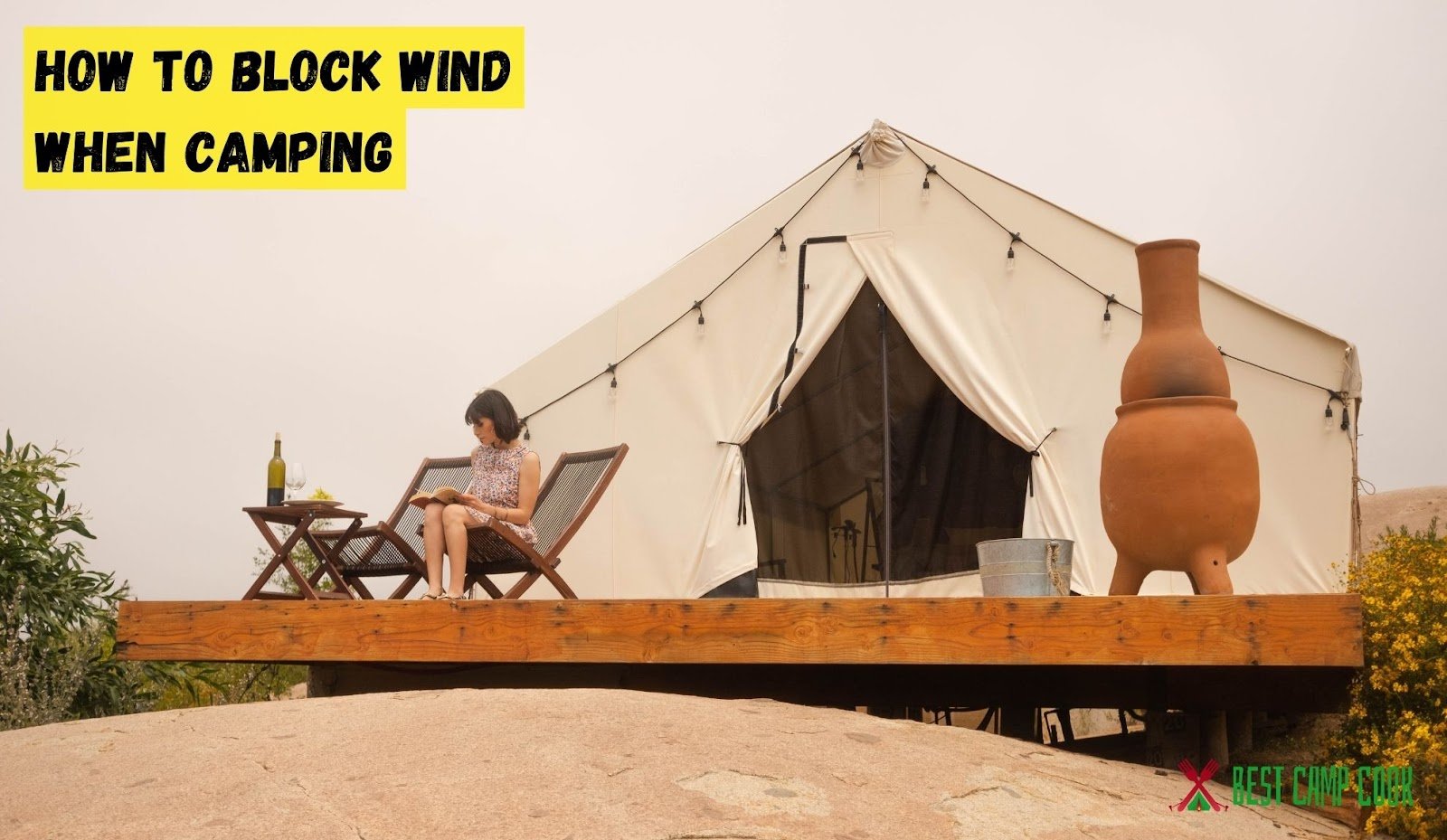
Tired of battling the relentless wind during your camping trips? We’ve got you covered! In this guide, we’ll show you exactly how to block wind when camping and reclaim tranquility in the great outdoors. Say goodbye to flapping tents and wild campfires.
With our practical tips, innovative techniques, and essential gear recommendations, you’ll be well-prepared to tackle gusty conditions like a pro. Don’t let the wind ruin your camping experience. Learn the art of blocking wind and enjoy calm and cozy nights under the stars.
Get ready to take control of the elements and make your next camping adventure a breeze!
Main Summary: How to block wind when camping?
To block the wind when camping, pick a sheltered site, strategically pitch tents, utilize natural barriers like trees and rocks, set up windbreaks using tarps or gear, and wear wind-resistant clothing. Stay cozy and wind-free on your outdoor adventures.
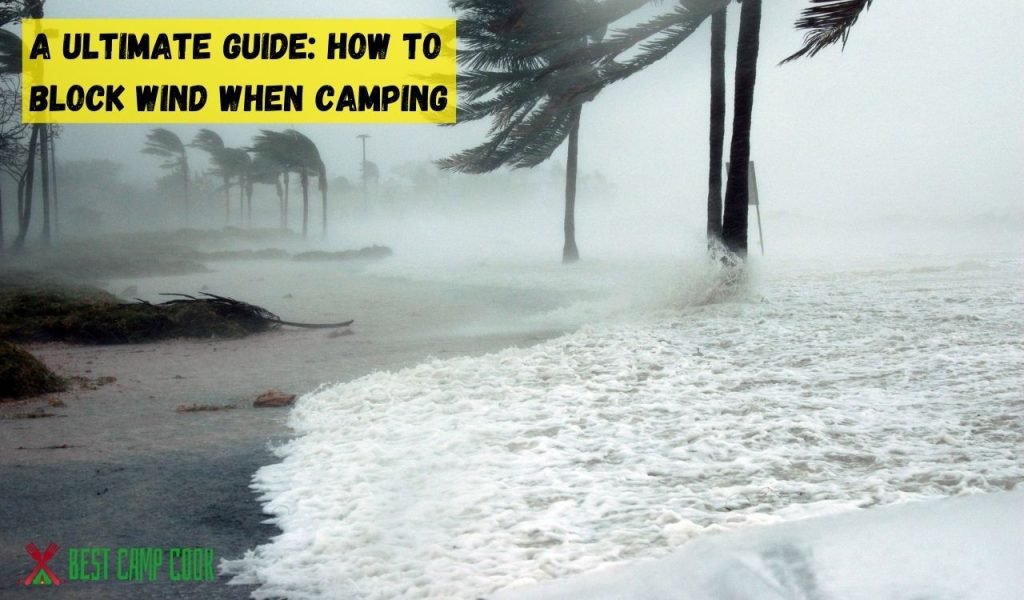
Camping in the great outdoors offers a unique connection with nature, but it’s important to consider the impact of wind on your camping experience. Understanding the effects of wind will enable you to make informed decisions and prepare accordingly for a comfortable and enjoyable trip.
Wind plays a crucial role in temperature regulation during camping. Even on a sunny day, a strong breeze can make the air feel significantly cooler due to the wind chill factor. This can affect your overall comfort and may necessitate additional layers of clothing or windproof gear to stay warm.
By understanding the interplay between wind and temperature, you can better plan and pack for varying weather conditions.
Cooking in windy conditions can be a real challenge for campers. The wind can interfere with your stove’s flames, making it difficult to cook meals or boil water efficiently. It’s important to address these challenges by implementing wind-blocking techniques.
Utilizing windbreak screens or creating a sheltered cooking area can help protect your flames from gusts, ensuring that you can prepare delicious campfire meals without frustration.
Strong winds can pose stability issues for your tent, especially if it’s not properly secured. It’s crucial to select a suitable campsite that offers natural windbreaks or utilize additional methods to minimize the impact. Ensuring your tent is securely staked and using guy lines can help stabilize it against gusts.
Additionally, choosing a tent with a streamlined design can reduce wind resistance and minimize flapping noise, allowing for a more peaceful night’s sleep.
Wind can also carry dust and debris, which can affect your camping experience. In arid or dusty environments, gusty winds can kick up sand, making it unpleasant to be outside.
Keeping your campsite organized and storing gear properly can help prevent dust and debris from causing discomfort or damage. Additionally, setting up windbreak barriers can reduce the amount of airborne particles entering your camping area.
Wind poses a significant risk to fire safety while camping. Strong gusts can cause fire to spread rapidly, endangering both your campsite and the surrounding environment. Always follow fire safety guidelines and regulations, which may include restrictions on open flames during windy conditions.
Ensuring your fire pit or cooking area is properly shielded from the wind and using wind-resistant fire-starting techniques can help prevent accidents and maintain a safe camping environment.
In extreme cases, high winds can pose a threat to personal safety during camping. Falling branches or trees, flying debris, or unstable structures can all be hazards during gusty conditions.
Stay vigilant, assess the weather forecast, and take appropriate precautions if inclement weather is expected. It’s essential to prioritize personal safety and make informed decisions to avoid potential risks associated with strong winds.
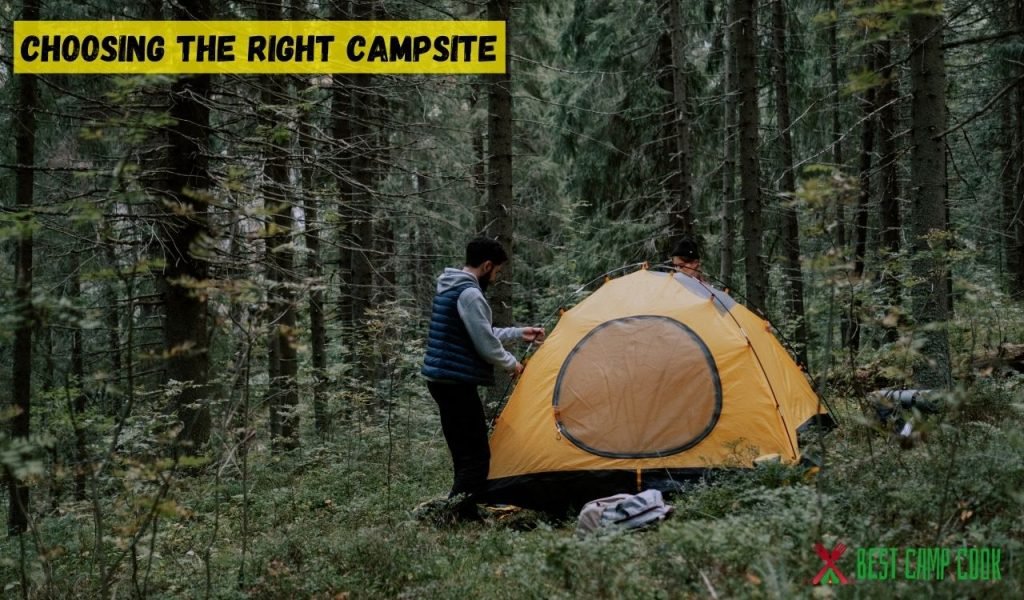
Selecting the ideal campsite is a crucial step in mitigating the effects of wind during your camping trip. By considering specific factors and making informed decisions, you can find a location that offers natural wind protection and enhances your overall camping experience.
The topography and surroundings of a campsite play a significant role in wind exposure. Look for locations that are sheltered by natural features such as hills, trees, or rock formations.
These natural windbreaks can provide valuable protection against strong gusts, creating a more comfortable camping environment. Avoid setting up camp in open, exposed areas where the wind is likely to be more intense.
Understanding wind patterns and direction can help you position your campsite strategically. Study weather forecasts and observe the prevailing wind direction in the area.
Position your tent and other camping equipment in a way that minimizes their exposure to the dominant wind direction. Orienting your tent with the back facing the wind can reduce the impact and prevent excessive flapping or instability.
Ensure that the chosen campsite offers a suitable clearing and level ground for pitching your tent. Avoid areas with tall grass, shrubs, or debris that can obstruct wind flow or cause damage to your gear.
Additionally, camping on level ground provides stability and prevents your tent from being excessively exposed to gusts.
While water sources such as lakes, rivers, or streams can enhance your camping experience, they may also be accompanied by increased wind activity. Bodies of water can create wind tunnels or amplify wind speeds.
Consider the proximity of your campsite to water sources and assess whether it will lead to excessive wind exposure. If possible, choose a location that strikes a balance between natural beauty and wind protection.
Different camping destinations have unique climates and weather patterns. Research and consider the local climate of your chosen camping area. Some regions are known for their high winds, while others may have more moderate or calm conditions.
By understanding the climate, you can select a campsite that aligns with your preferences and minimizes the impact of wind.
Maintaining a flexible mindset and being adaptable can be beneficial when selecting a campsite. Weather conditions can change rapidly, and wind patterns may vary throughout the day.
Have alternative campsite options in mind, allowing you to relocate if necessary. Being prepared to adjust your plans ensures that you can find a suitable site that offers the best possible protection against wind.
Once you have chosen the optimal campsite, the next step is to set up windbreakers and barriers to further shield yourself from the effects of wind. These structures and techniques can significantly improve your camping experience by reducing wind exposure and creating a more comfortable outdoor environment.
Take advantage of natural features in the vicinity of your campsite to act as natural windbreaks. Trees, bushes, large rocks, or even the contour of the land can provide valuable protection against gusts.
Position your tents and other camping equipment in a way that maximizes the shielding effect of these natural elements. Carefully consider their height, density, and direction in relation to prevailing winds for optimal wind protection.
When setting up your tents, pay attention to their orientation and positioning. Align the tent entrance away from the dominant wind direction to minimize the direct impact of gusts.
Staking the tent securely and using guy lines can add stability and prevent flapping or collapse in strong winds. Additionally, consider using a windproof tent specifically designed to withstand harsh weather conditions.
Creating windbreak walls can provide an effective barrier against wind. Use sturdy materials such as tarpaulin, waterproof fabric, or even solid panels to construct a wall that blocks wind from a specific direction.
Position the wall strategically to shield your campsite and cooking area. Ensure that the wall is firmly anchored to the ground and tightly secured to withstand gusts.
If you have vehicles present at your campsite, utilize their windshields as additional windbreakers. Position the vehicles strategically to create a barrier against the prevailing winds. Ensure that the vehicles are parked securely and safely, taking care not to obstruct traffic or access routes.
In areas where natural windbreaks are limited, you can construct temporary rock walls to serve as wind barriers. Collect rocks or boulders and arrange them in a solid line to create a wall that intercepts wind.
Place smaller rocks or boulders on top of the larger ones to enhance stability. This method is particularly useful in open, exposed areas where natural wind protection is scarce.
Setting up canopies or awnings can provide an additional layer of protection against wind. These structures not only offer shade but also act as windbreakers, reducing the impact of gusts on your camping area.
Securely anchor the canopies or awnings to prevent them from being lifted by strong winds. Choose sturdy materials that can withstand the elements.
Creating a windproof cooking area is essential for a successful camping trip. Shielding your cooking equipment and fire from wind not only enhances safety but also improves cooking efficiency.
Set up cooking stations close to natural windbreaks or create temporary barriers using screens or heat-resistant materials. Ensure proper ventilation to prevent smoke accumulation.

When embarking on a camping trip in windy conditions, equipping yourself with the right gear is essential for ensuring a comfortable and enjoyable outdoor experience.
Windproof camping gear can make a significant difference in protecting you from the chilling effects of gusts and maintaining a cozy campsite atmosphere. Here are some key considerations and gear options to help you effectively block wind during your camping adventures.
Investing in a windproof tent is a fundamental step in safeguarding yourself against strong winds. Look for tents specifically designed to withstand gusts, as they often feature robust construction, reinforced poles, and aerodynamic designs. These tents are engineered to minimize wind resistance and maintain stability even in blustery conditions.
To further enhance wind protection, choose a tent with a solid rainfly that extends close to the ground, effectively sealing off any potential entry points for wind.
Shielding yourself from the penetrating effects of wind starts with wearing windproof clothing. When selecting garments, opt for those made from wind-resistant materials that provide insulation and effectively block gusts.
Windproof jackets, pants, and hats act as a protective barrier, preventing cold air from reaching your body and ensuring optimal warmth and comfort. Layering your clothing is also a smart strategy, as it traps warm air between the layers and adds an extra level of wind resistance.
A restful night’s sleep is crucial during a camping trip, and windproof sleeping bags play a vital role in providing insulation and blocking gusts. Look for sleeping bags specifically designed for windy conditions, featuring durable materials and insulation that effectively retain heat.
Draft collars and adjustable hoods are additional features to consider, as they help seal in warmth and prevent cold air from entering. Furthermore, using a sleeping pad or insulated air mattress provides an extra layer of insulation between you and the cold ground, enhancing overall comfort and protection from wind.
For outdoor enthusiasts who enjoy cooking meals while camping, using a windproof stove is paramount. Wind can easily extinguish flames and make cooking a challenge, but with a windproof stove, you can maintain efficient cooking even in blustery conditions. Look for stoves with built-in wind shields or consider purchasing separate wind screens.
These shields effectively block gusts, creating a more controlled environment for cooking. Lightweight and compact stoves are ideal for camping, as they are easy to set up, operate, and transport.
In addition to personal gear, windproof canopies and shelters provide excellent protection against gusts and create a comfortable outdoor living space. These structures are designed with sturdy materials and construction, allowing them to withstand wind and provide a shielded area for relaxation, cooking, or socializing.
When selecting a windproof canopy or shelter, consider factors such as stability, ease of assembly, and resistance to strong gusts.
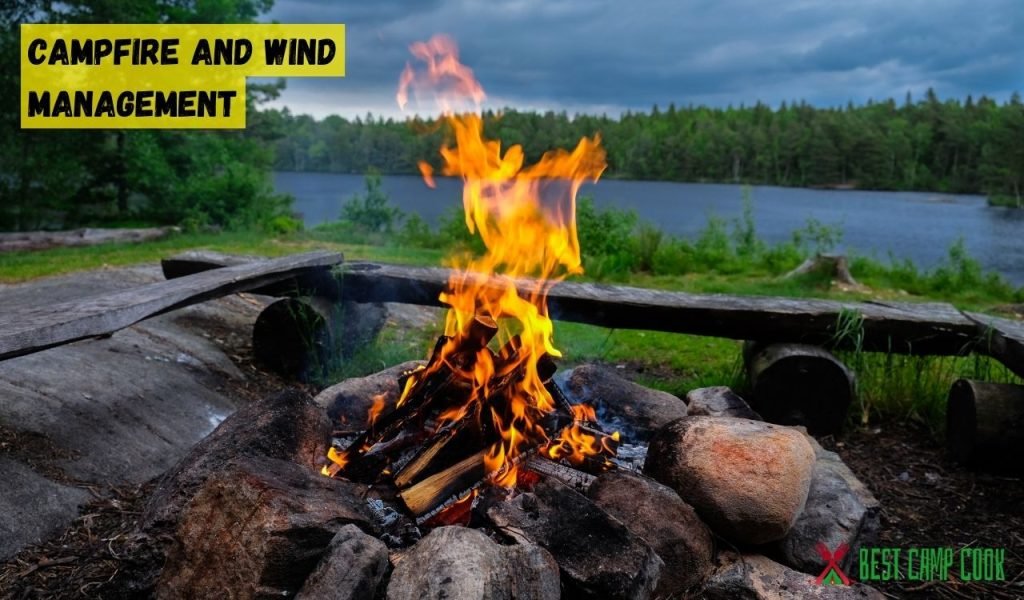
When camping, a cozy campfire can create a warm and inviting atmosphere. However, windy conditions can pose challenges to maintaining a steady and safe campfire. Effective campfire and wind management techniques are essential to ensure both comfort and safety during your outdoor adventures.
Here are some important considerations and strategies to help you navigate campfire and wind management effectively.
Choosing the right location for your campfire is crucial, especially in windy conditions. Look for natural windbreaks such as dense vegetation, large rocks, or natural formations that can provide a barrier against gusts. These features help create a sheltered area where the fire can thrive and maintain a consistent burn.
Additionally, consider the wind direction and position your campfire in a way that maximizes the natural windbreaks’ effectiveness.
Constructing a proper fire pit is another key aspect of campfire and wind management. Start by clearing the area from any dry leaves, twigs, or debris that can catch fire and potentially spread. Dig a pit in the ground and surround it with rocks or stones to contain the fire.
The rocks act as a barrier against the wind, preventing it from directly impacting the flames. Ensure that the fire pit is deep enough to hold the fire securely and prevent sparks from escaping.
In situations where natural windbreaks are scarce or insufficient, building a windbreak around your campfire can provide an effective solution. Use large rocks, logs, or even camping gear to create a physical barrier on the windward side of the fire pit.
The windbreak should be tall enough to block gusts and wide enough to redirect them away from the flames. This barrier helps maintain a more controlled environment, allowing the fire to burn steadily and reducing the risk of sparks flying around.
Managing the airflow to your campfire is crucial for maintaining a consistent burn. In windy conditions, the gusts can either fuel the fire excessively or cause it to smolder. Controlling the airflow can be achieved by strategically positioning yourself and other objects around the fire.
You can use your body as a shield against the wind or sit close to the fire to redirect the airflow. Additionally, using adjustable fire grates or screens can help regulate the amount of air reaching the fire, preventing it from getting too intense or extinguishing it.
Once you are done enjoying your campfire, it is essential to extinguish it properly, especially in windy conditions. Use water or sand to douse the flames, ensuring that all embers are completely extinguished.
Stir the ashes to expose any hidden hot spots and continue pouring water until everything is cool to the touch. In windy conditions, pay extra attention to thoroughly extinguishing the fire to prevent any accidental reignition or the spread of sparks.
When camping in windy conditions, it’s essential to explore innovative techniques for effectively blocking the wind. By employing creative solutions, you can enhance your camping experience and create a more comfortable and enjoyable outdoor environment. Here are some inventive techniques to help you block wind during your camping adventures:
Nature provides us with natural windbreakers that can significantly reduce the impact of strong gusts. Look for areas with dense vegetation, such as thick forests or groves of trees. These natural barriers act as excellent shields against the wind, creating a calmer and more sheltered camping space.
Additionally, consider camping near cliffs, rock formations, or hillsides that can provide protection from the wind. Utilizing these natural windbreakers can help create a more pleasant camping environment while minimizing the need for additional equipment.
Using tarps to create temporary walls around your campsite is a practical and versatile technique for blocking wind. Attach one end of the tarp to a sturdy anchor point, such as a tree or a pole, and stretch it out to create a barrier. Secure the other end to the ground using stakes or heavy rocks.
By positioning the tarps strategically, you can effectively redirect the wind away from your camping area. This technique not only blocks the wind but also provides some privacy and helps create a cozy atmosphere.
Investing in a windproof camping tent is a game-changer when it comes to camping in windy conditions. These specialized tents are designed with sturdy materials and innovative features to withstand strong winds. Look for tents with aerodynamic shapes, reinforced poles, and robust guylines.
These elements help the tent maintain its structure and stability, reducing the impact of gusts. Additionally, choose a tent with a full-coverage rainfly that can provide an extra layer of protection against the wind. By using a windproof tent, you can sleep comfortably and enjoy your camping experience even in blustery conditions.
Portable windbreaks are practical accessories that can be easily carried and set up at your campsite. These lightweight barriers are designed to block the wind and create a sheltered area. They are typically made of durable materials such as nylon or polyester and feature adjustable poles for flexibility in positioning.
Portable windbreaks are available in various sizes and styles, allowing you to customize the level of protection based on your needs. They can be positioned strategically to shield your cooking area, seating area, or even your tent entrance from the wind.
Take advantage of the natural features present at your campsite to block the wind effectively. For example, if you have large boulders or fallen trees nearby, arrange them strategically to create a barrier against the wind.
Position your tents, seating areas, and cooking areas in areas that are naturally sheltered, such as behind a large rock or within the alcove of a hillside. By utilizing these existing natural features, you can minimize the impact of the wind and enhance your camping experience.
In addition to setting up physical barriers, it’s important to protect yourself from the wind with windproof clothing and accessories. Invest in wind-resistant jackets, pants, and hats that are designed to block the wind and keep you warm. Look for garments made from windproof materials that offer both insulation and breathability.
Additionally, consider using windproof face masks, gloves, and neck gaiters to protect exposed areas from chilly gusts. By wearing windproof clothing and accessories, you can stay comfortable and enjoy your outdoor activities even in blustery conditions.
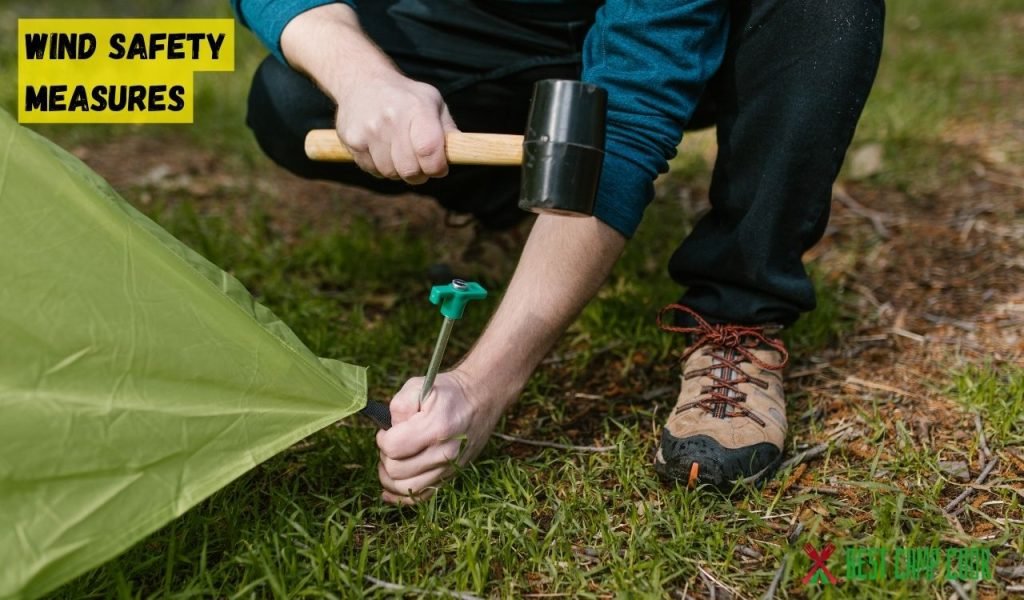
When camping in windy conditions, it’s crucial to prioritize safety and take necessary precautions to ensure a secure and enjoyable camping experience. Here are some important wind safety measures to keep in mind:
One of the primary safety concerns during windy camping is the stability of your tent. Properly securing your tent is essential to prevent it from being blown away or collapsing. When selecting a campsite, look for a location with natural windbreaks or features that can provide additional protection. Once you’ve chosen your spot, make sure to stake down your tent securely.
Use sturdy tent stakes and consider using additional guy lines or anchors to reinforce the structure. Tension the guy lines properly to provide stability against strong gusts. Regularly check and tighten the tent stakes and guy lines throughout your camping trip to maintain the tent’s integrity.
In high-wind conditions, it’s crucial to avoid camping near hazardous areas that can pose additional risks. Steer clear of areas with dead or unstable trees that can potentially fall due to strong gusts. Keep a safe distance from cliff edges or steep slopes where wind can become unpredictable and powerful.
Additionally, be cautious of camping near bodies of water, as strong winds can create dangerous waves or surges. Choose a campsite that offers natural barriers and protects you from potential hazards associated with the wind.
Camping often involves enjoying a cozy campfire, but wind can present challenges when it comes to fire management. When setting up a campfire in windy conditions, take extra precautions to prevent the fire from spreading or becoming uncontrollable. Position your fire pit in a sheltered area, such as behind a natural windbreak or within a designated fire ring or pit.
Clear the surrounding area from flammable materials, including dry grass, leaves, and debris. Keep a ready supply of water or a fire extinguisher nearby to quickly extinguish the fire if necessary. Always monitor the fire closely and never leave it unattended, especially in windy conditions.
Exercise caution when dealing with campfires in windy conditions. Make sure your fire is well-contained within a fire pit or designated area, and always follow local regulations and guidelines. Avoid building large fires that can become difficult to control in strong winds.
Before embarking on your camping trip, thoroughly inspect your camping equipment and gear to ensure they are wind-ready. Check the integrity of your tent poles, stakes, and guy lines. Replace any damaged or worn-out components to ensure they can withstand the wind’s force.
Verify that your camping stove is stable and equipped with wind guards or shields to prevent flameouts or accidental fires. Secure loose items around your campsite, such as chairs, tables, or cooking utensils, to prevent them from being blown away by strong gusts.
Regularly assess your equipment throughout your camping trip and make adjustments as necessary.
Even with careful planning and precautions, unexpected weather conditions can arise. It’s crucial to be prepared for emergencies caused by high winds. Pack a well-stocked first aid kit that includes items for treating minor injuries and potential wind-related issues like windburn or chapped skin.
Stay updated on weather forecasts and have a plan in place for seeking shelter if the wind becomes too severe. Familiarize yourself with the nearest emergency exits, evacuation routes, or designated safe areas in case of an emergency.
Always prioritize your safety and be ready to adapt your plans based on changing weather conditions.
In extreme wind conditions or during severe weather events, be prepared to evacuate your campsite if necessary. Have an emergency plan in place and know the evacuation routes and nearby safe locations where you can seek shelter.
In conclusion, blocking wind when camping is essential for a comfortable and safe outdoor experience. By using windproof camping gear, managing campfires wisely, employing innovative techniques, and prioritizing wind safety measures, you can enhance your camping trip even in blustery conditions.
Remember to stay prepared, stay cautious, and make smart choices to make the most of your camping adventure while keeping wind at bay. Happy camping!
Blocking wind when camping is important for several reasons. It helps create a more comfortable environment by reducing wind chill and preventing gusts from blowing away your belongings. It also helps to maintain the stability of your camping equipment, such as tents and cooking setups, ensuring they function properly and remain secure.
Wind can significantly impact your camping experience. It can make the temperature feel colder, create challenges when starting and maintaining campfires, cause discomfort by blowing dust and debris into your campsite, and even pose safety hazards by destabilizing tents or structures.
There are several practical ways to block wind at a campsite. You can choose a sheltered campsite location, pitch your tent behind natural windbreaks like trees or rocks, set up windbreakers or barriers such as tarps or camping screens, and use windproof camping gear like wind-resistant tents, stove windshields, and windproof clothing.
To choose a campsite with natural wind protection, look for locations surrounded by trees, shrubs, or other vegetation that can act as windbreaks. Avoid camping on hilltops or open areas, as they are more exposed to strong winds. Additionally, consider the direction of prevailing winds and position your campsite accordingly.
There are various types of windbreakers or barriers you can use when camping, including camping screens, pop-up canopies, tarps, or even makeshift walls using rocks or logs. These can be strategically placed to block or redirect the wind, creating a more sheltered camping area.
Yes, there is specific camping gear designed to block wind. Wind-resistant tents are available that have sturdy frames and aerodynamic shapes to withstand strong gusts. Stove windshields can be used to protect your cooking flame from wind, ensuring efficient heating. Windproof clothing and accessories like jackets, hats, and gloves can also help block the wind and keep you warm.
When blocking wind during camping, it’s important to consider safety. Avoid placing flammable items too close to campfire windbreakers or barriers. Ensure that your windbreakers are securely anchored and won’t pose a tripping hazard.
Be cautious of any sharp edges or potential hazards when setting up barriers. Additionally, always follow fire safety guidelines and local regulations when dealing with fires at your campsite.
Yes, there are several DIY windblocking techniques you can use. You can create a windbreak by stacking rocks or logs to form a low wall, fashion a windscreen using PVC pipes and a tarp, or even repurpose existing camping gear like backpacks or camp chairs to create a makeshift wind barrier.
While tents provide some level of wind protection, they are not designed to function as windbreakers. It’s advisable to set up additional windbreakers or barriers around your campsite to create a more effective shield against strong winds.